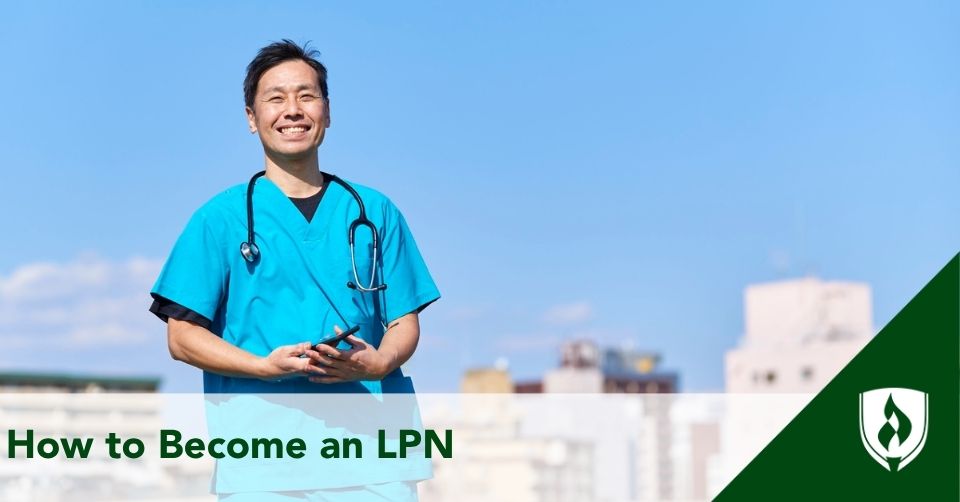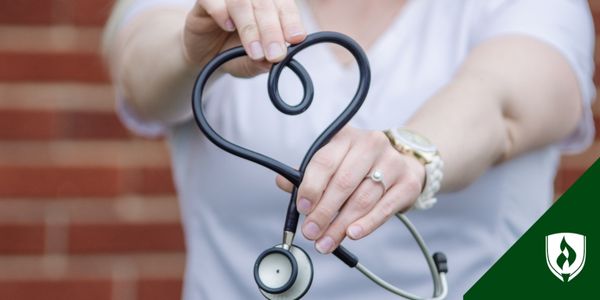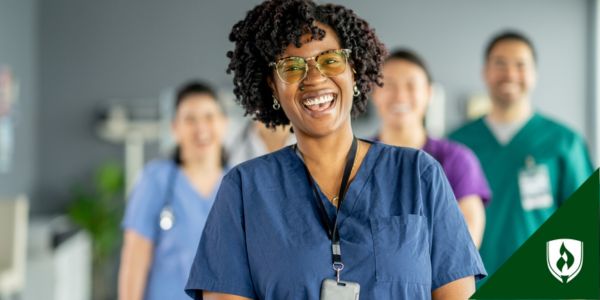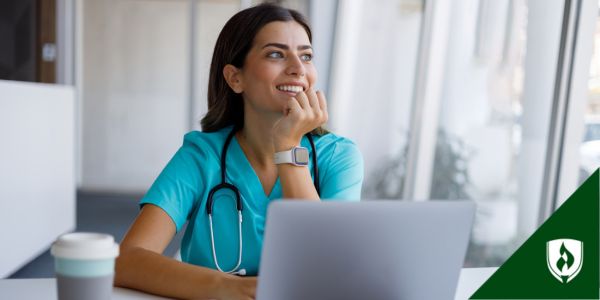How To Become a Licensed Practical Nurse (LPN)
11/06/2025

Licensed practical nurses (LPNs) provide1 foundational care to patients in a variety of healthcare settings. Working under the supervision of registered nurses (RNs) and physicians, LPNs1 assist with daily care activities, monitor vital signs, and help ensure effective communication within healthcare teams.
If you're ready to take the next step and become an LPN, the path1 may include completing an approved educational program and passing the required licensure examination for practical nurses.
Exploring LPN Education Requirements
To become an LPN, you’ll need to complete an approved educational program. These programs are offered2 at Rasmussen University.
At Rasmussen, the Practical Nursing Diploma program2 can be completed in as few as 12 months of full-time study, may provide students the opportunity to move forward without years of prerequisite coursework. The program includes 15 nursing courses (56 credit hours) with both classroom learning and clinical experience.
- Hybrid format: Coursework is available through a combination of online and on-campus classes.
- Eight start dates each year: Offering flexibility for students who are ready to begin at different times.
- No waiting list at many campuses: Qualified applicants can often start without delay.
- Accreditation: Rasmussen’s practical nursing program is accredited by the Accreditation Commission for Education in Nursing (ACEN), ensuring high educational standards.
A high school diploma (or equivalent) is typically required2 for admission. Rasmussen also requires students to pass an entrance exam unless they hold a higher-level degree with a qualifying GPA.
LPN Education and Training
LPN education combines classroom instruction with supervised clinical training.
At Rasmussen, some of the courses include:2
- Practical Nursing Skills I
- Principles of Gerontological Nursing
- Principles of Mental Health Nursing
- Structure and Function of the Human Body
In addition to coursework, students may gain2 hands-on clinical experience working directly with patients, administering medication, taking vital signs, and collaborating with the healthcare team.
LPN Licensure Examination
The NCLEX-PN® exam is a national licensure examination3 for practical nurses required to obtain an LPN license.
Rasmussen’s practical nursing program2 may prepare students through coursework, clinical practice, and exam-focused preparation.
- Format: The exam is computer-based and covers areas such as basic care, pharmacology, blood pressure, other vital signs, and patient safety.
- Preparation support: Rasmussen offers resources such as advising, tutoring, and practice opportunities.
- Pass rates: In 2024, 95.2% of Rasmussen LPN students in Florida successfully completed the NCLEX-PN.
120 out of 126 Rasmussen University LPN graduates in Florida (95.2%) who attempted the NCLEX-PN exam in 2024 passed on their first attempt.4
Passing the NCLEX-PN exam is required before applying for licensure with your state board.
Becoming a Licensed Practical Nurse
After completing a practical nursing program and passing the NCLEX-PN, students can apply2 for a nursing license through their state’s board of nursing. License renewal and continuing education are often required to maintain the lpn license.
Rasmussen also offers2 an LPN to RN Bridge program, providing a path for practical nurses to pursue an associate degree or BSN program. Credits from the LPN diploma can transfer into bachelor’s degree programs or BSN degree online, streamlining the process for those who continue their studies.
Common LPN Skills and Qualities
Practical nursing combines technical training2 with personal qualities that support safe and effective patient care. LPNs draw on both professional knowledge and interpersonal strengths in their day-to-day job duties.
- Compassionate Patient Care: Supporting patients through daily care, recovery, and basic care for older patients or those with chronic conditions.
- Healthcare Industry Insight: Learning from experienced nursing faculty and leadership who provide a strong foundation in the health professions.
- Critical Thinking and Confidence: Responding to real-world scenarios in clinical settings and acting quickly in the interest of patient health.
- Experience Across Healthcare Settings: Gaining clinical experience in environments such as nursing care facilities, clinics, and long-term care.
- Patient Care Skills: Including vital signs, administering medication, and basic life support.
- Organization and Accuracy: Keeping thorough records, managing tasks in fast-paced environments, and supporting treatment plans.
LPN Specialized Training and Certifications To Consider
Many practical nurses choose to pursue specialized certifications5 to expand their expertise and focus on areas that match their interests. Examples include wound care, IV therapy, pediatrics, gerontology, and care for patients with chronic conditions.
Specialized training may provide LPNs the opportunity5 to develop advanced skills in basic care, patient monitoring, and supporting treatment plans in various healthcare facilities. Certifications can also help practical nurses take on more responsibilities in residential care facilities, nursing care facilities, and clinics.
Through their LPN education, students are introduced to a range of clinical settings, giving them insight into which areas may align best with their values, strengths, and career path in the nursing profession. Professional associations like NAPNES®6 also offer credentialing opportunities, further validating skills in specialty areas.
LPN Program Accreditation and Approval at Rasmussen
Rasmussen University is accredited2 by the Higher Learning Commission (HLC), an institutional accreditation agency recognized by the U.S. Department of Education.
The practical nursing program2 at Rasmussen is Accreditation Commission for Education in Nursing (ACEN)-accredited at multiple campuses:
- Central Pasco campus (Odessa, Florida), Continuing Accreditation
- Eagan campus (Eagan, Minnesota), including an off-campus instructional site in Hennepin/Anoka, Continuing Accreditation
- Mankato campus (Mankato, Minnesota), Continuing Accreditation
- Moorhead campus (Moorhead, Minnesota), Continuing Accreditation
- St. Cloud campus (St. Cloud, Minnesota), Continuing Accreditation
Review the public information disclosed by the ACEN regarding these programs at acenursing.org/search-programs.
In addition, Rasmussen’s Practical Nursing Diploma program2 is approved by state boards of nursing, ensuring students meet both national council standards and state-specific requirements for licensing exams. For example, the Moorhead, Minnesota campus program is approved with conditions by the Minnesota Board of Nursing, which monitors pass rates on the NCLEX-PN and ensures compliance with state requirements.
The combination of national and state accreditation ensures that students are receiving high-quality LPN education, clinical experience, and preparation for the NCLEX-PN and other professional requirements.
Accreditation also enables credits to transfer into associate degree, BSN degree online, or bachelor's degree programs, supporting additional education and future growth in the nursing profession.
Next Steps in Making Your Decision
To become an LPN, consider your goals, values, and skills. Think about the type of health care services you want to provide and which settings could make the most sense.
Choosing the right practical nursing program involves evaluating accreditation, clinical opportunities, and flexibility to ensure your education aligns with your priorities. Start by reviewing education requirements, program formats, and specialized training options.
When considering your next steps, you may want to explore how Rasmussen’s program2 may provide you with the training to sit for the NCLEX-PN exam and, upon successful completion, apply for licensure through your state board. By matching your strengths and values with the right program, you’ll make an informed decision that supports your future in the nursing profession.
NCLEX-PN® is a registered trademark of The National Council of State Boards of Nursing, Inc. 111 East Wacker Drive Suite 2900 Chicago, ILLINOIS UNITED STATES 60601
National Association for Practical Nurse Education & Service, Inc.® and NAPNES® are registered trademarks of the National Association for Practical Nurse Education & Service, Inc.
1American Nurses Association, "How to Become a Licensed Practical Nurse," https://www.nursingworld.org/content-hub/resources/becoming-a-nurse/how-to-become-a-licensed-practical-nurse/ (accessed October 3, 2025).
2Rasmussen University, "Practical Nursing Program," https://www.rasmussen.edu/degrees/nursing/practical-nursing/ (accessed October 3, 2025).
3National Council of State Boards of Nursing, "NCLEX-PN Examination," https://www.nclex.com/ (accessed October 3, 2025).
4Florida Board of Nursing, "Report 4 – Jurisdiction Program Summary of all First-Time Candidates Licensed in All Jurisdictions," https://floridasnursing.gov/pdfs/Report4%E2%80%93PN-2024-JurisdictionProgramSummary.pdf
5PracticalNursing.org, "Specialty Certification for LPNs," https://www.practicalnursing.org/specialty-certification-lpns (accessed October 3, 2025).
6National Association for Practical Nurse Education and Service (NAPNES), https://napnes.org/site/ (accessed October 3, 2025).



